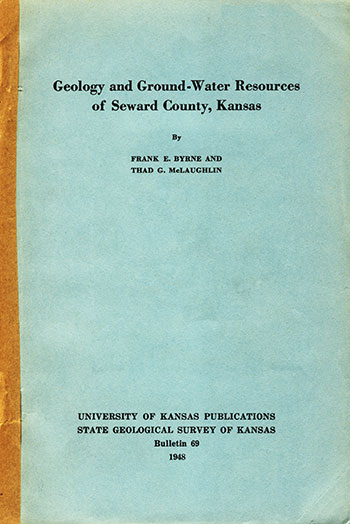Geology and Ground-water Resources of Seward County, Kansas
by Frank E. Byrne and Thad G. McLaughlin
with analyses by Robert H. Hess

Originally published in 1948 as Kansas Geological Survey Bulletin 69. This is, in general, the original text as published. The information has not been updated.
You may also wish to visit our web site on the Seward County geologic map.
Abstract
The report describes the geography, geology, and groundwater resources of Seward County in southwestern Kansas. The county has an area of 643 square miles and had a population of 6,593 in 1940. The area consists predominantly of flat to rolling upland plains which are broken only by the valley of the Cimarron River, which extends diagonally across the county. The climate is semiarid, the average annual precipitation being about 18 inches. The principal occupations in the area are farming and livestock raising.
The report includes a map showing the areas of outcrop of the rock formations (Pl. 1). The Meade and Kingsdown formations and dune sand underlie the upland areas and the Meade, Rexroad (?), and Laverne formations are exposed along the sides of Cimarron Valley. The floor and lower slopes of the valley are underlain by alluvium and colluvium. The report also contains a diagrammatic cross section of the area showing the distribution of the rock formations above the Permian redbeds as determined by extensive test drilling (Pl. 3).
The report contains a map of the area showing the depth to water level by means of shading (Pl. 2). The water table ranges in depth from less than 10 feet in parts of Cimarron Valley to more than 200 feet in parts of the upland. A map showing by contours the shape and slope of the water table is also included in this report. The contours show that ground water moves eastward through Seward County and that the gradient of the water table ranges from about 4 feet to the mile in the northeastern part of the county to about 40 feet to the mile in the southwestern part of the county.
The groundwater reservoir is recharged principally from precipitation that falls within the area, by percolation from intermittent streams, and by subsurface inflow from adjacent areas. Ground water is discharged from the groundwater reservoir by movement into adjacent areas, by evaporation and transpiration in areas of shallow water table, by seepage into Cimarron River, and by wells. All the domestic, public, industrial, and irrigation supplies and much of the stock supply are obtained from wells.
Ground water in Seward County is hard, but is suitable for most ordinary uses. Waters from the Laverne, Rexroad (?), and Meade formations are similar in composition and in hardness. Waters from the alluvium generally are of poorer quality.
The principal water-bearing formations in Seward County are the Rexroad (?), Laverne, and Meade formations, but a few domestic and stock wells obtain water from alluvium in the Cimarron Valley. The character and water supply of each formation are discussed in the report.
The field data upon which most of the report is based are given in Table 10 and include records of 162 wells and chemical analyses of the waters from 20 representative wells. Logs of 35 test holes, water wells, and oil and gas wells in the area are given, including 23 test holes put down by the State and Federal Geological Surveys.
Kansas Geological Survey, Geohydrology
Web version Sept. 2001. Original publication date March 1948.
Comments to webadmin@kgs.ku.edu
The URL for this page is http://www.kgs.ku.edu/General/Geology/Seward/index.html